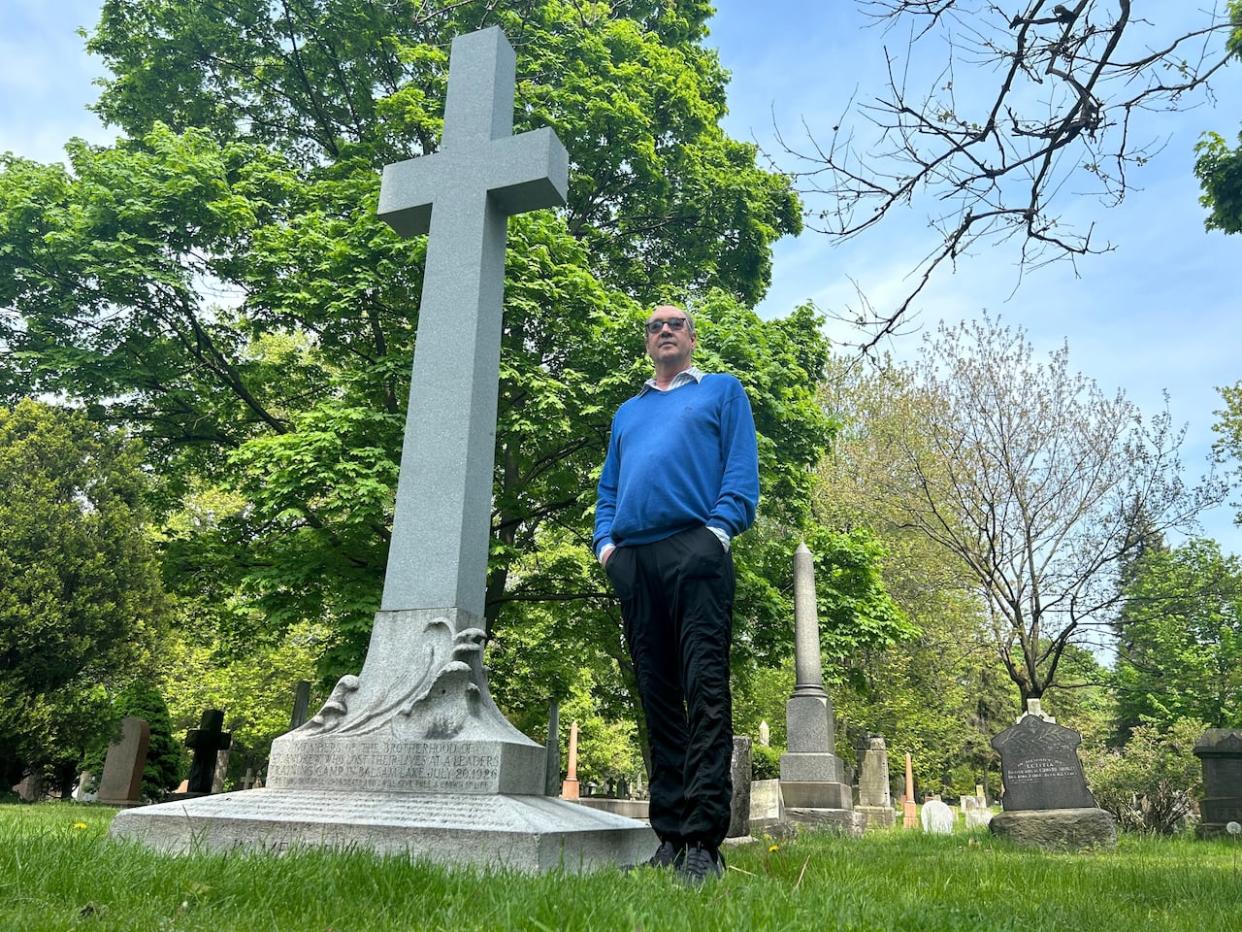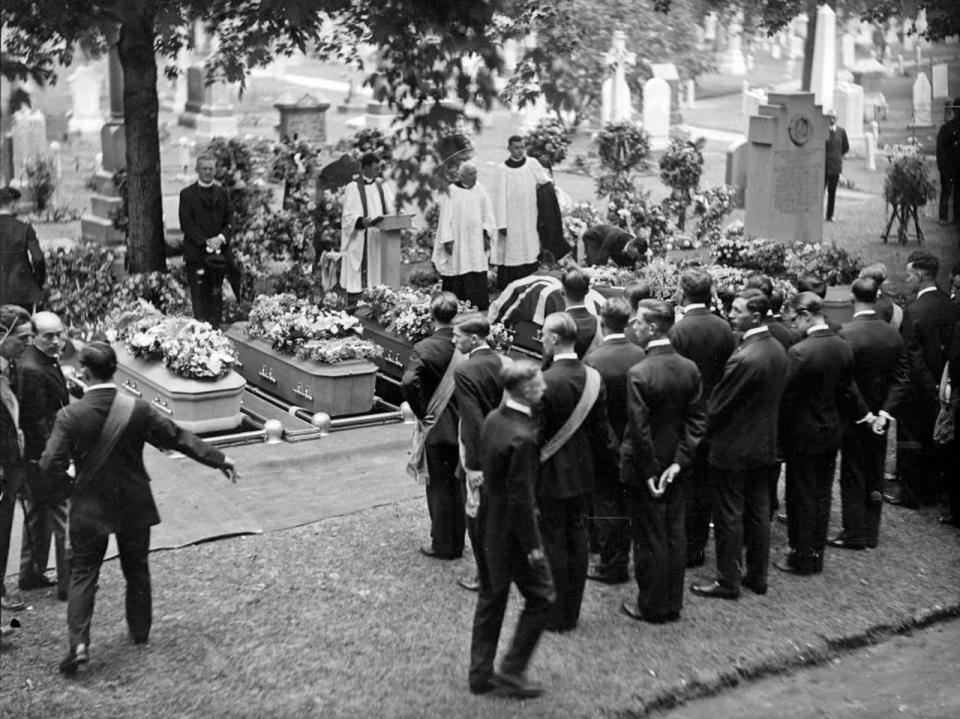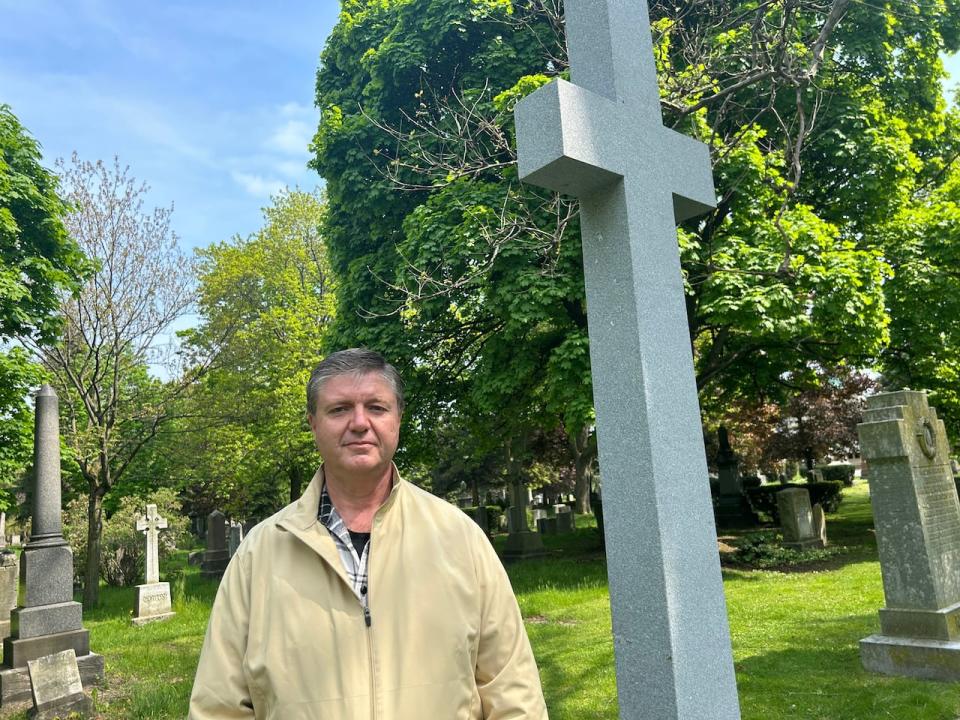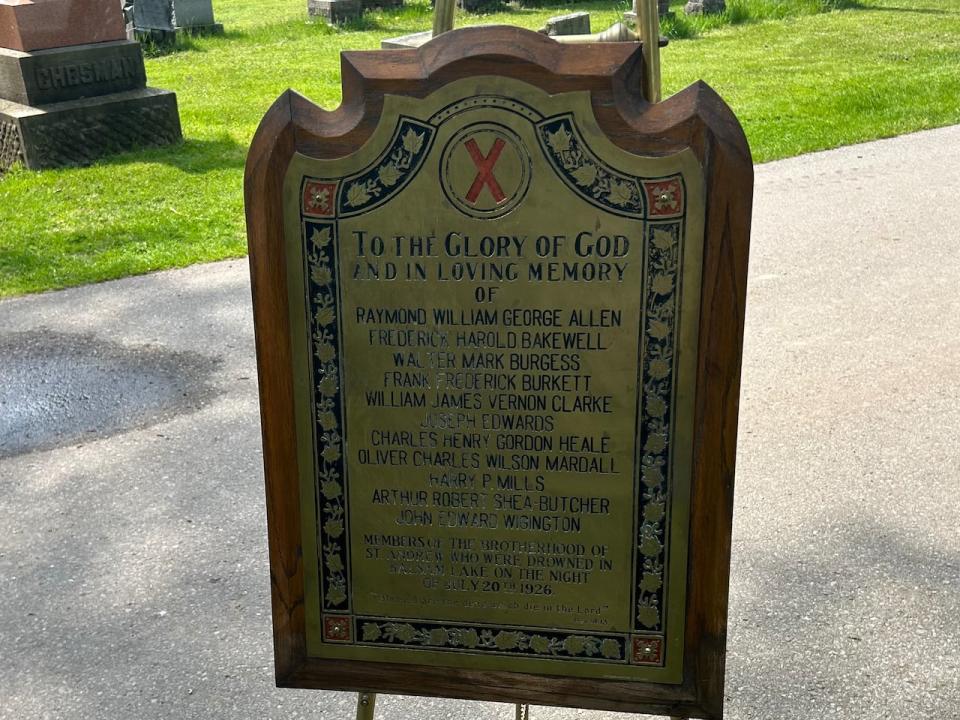Monument to 11 who died in Balsam Lake canoe disaster restored

In Vicki Wagner's family, it's simply referred to as "the tragedy."
Almost 100 years ago, placid Balsam Lake, in the heart of the Kawarthas, was the scene of one of the worst pleasure craft disasters in provincial history: 11 boys and young men drowned when their oversized canoe capsized, in the dark waters, far from shore.
Only four of the paddlers survived — including Wagner's grandfather, 15-year-old Leonard O'Hara.
"Tears were in his eyes when I asked him (about the tragedy)," she recalled during an interview at her Ajax home last week. "He was alive and he wasn't able to save his friends. I think that was very hard for him."

Vicki Wagner holds a picture of her grandfather, Leonard O'Hara, who was one of four people to survive the tragedy. (Mike Smee/CBC)
Most of the victims were Toronto boys. Their funerals and subsequent burial beneath a massive, roughly four-metre-high cross at St. James Cemetery, near Bloor and Parliament streets, made headlines around the world, in July of 1926.
As a poignant addition, a small stone perimeter around the graves was etched with the names of all 11 victims.
But as the decades passed, so did the city's memories of the tragedy.
The engraved stone rim became overgrown with weeds. Vandals toppled the once imposing granite cross years ago; it was left as it fell.

Seven of the victims were buried side by side in St. James' Cemetery. Most of the victims were from Toronto and as this Toronto Globe photo shows, the ceremony was a major event. (City of Toronto Archives)
But now, thanks to Balsam Lake resident Doug Paterson, Toronto's St.James Cemetery has refurbished the site, landscaping the graves and replacing the stone cross. It'll all be officially unveiled at a special rededication ceremony, to be held June 20.
Paterson, who grew up on the lake, says he's been fascinated with tragedy since he first heard about it, as a boy.
"My mom used to drag us up to church in Kirkfield and I remember sitting there looking at a plaque in the church that listed the victims' names; it was so interesting," he recalled. "So it was part of my life from the time I was a very small child."
Over the years he's pieced together what is probably the most comprehensive collection of facts and anecdotes about the tragedy.

George Vrozos, general manager of St. James' Cemetery, said the cathedral went to great pains to ensure the new monument is an exact replica of the original. (Mike Smee/CBC)
It happened shortly after a group of boys arrived at an Anglican Church leadership camp on Balsam Lake's Long Point.
The camp's two adult directors, Robert Shea-Butcher, a World War I veteran who couldn't swim, and Arthur Lambden, asked for volunteers to canoe into the nearby town of Coboconk to pick up two more canoes and other supplies, spend the night in town and paddle back in the morning.
The fifteen set off shortly after dinner, but soon after they departed the winds picked up, and in the choppy water, the large canoe capsized.
The boys clung to the canoe, but in the frigid, dark waters, they began to drift away.

The plaque that commemorates the 11 victims of the Balsam Lake tragedy now resides at the museum in Kirkfield. (Mike Smee/CBC)
"He was trying to help the other boys survive," Wagner says of her grandfather. "He was supporting them in the water. They sang "Abide by Me."
Of the two adult camp leaders on board, only Lambden survived.
He later described the heartbreaking scene to the Toronto Star:
"The boys dropped off [the canoe] one by one as their strength failed them. They went to their death without a whimper and to the last unselfishly trying to help the other fellow."
Hours in the water
After hours in the water, the four survivors made it to Grand Island in the middle of the lake, where they were forced to spend a cold, wet night. A search party found them the following day.
Paterson points out that although life jackets had been invented by 1926, none were on board the canoe. As well, no one attempted to find out which of the boys could swim, or who had paddling experience - whoever volunteered was allowed to go.
Despite this, a public inquiry, held in Lindsay in August, 1926, laid no blame, ruling the deaths a tragic accident.
Public is invited
The restoration of the monument and next month's graveside re-dedication ceremony were arranged by St. James Cathedral at a cost of about $13 thousand, church staff say, after lobbying by Paterson.
The rebuilt cross "is an exact replica, to the millimetre," cemetery general manager George Vrozos says. "It was our honour and our privilege to make sure this was done properly and respectfully, to memorialise the lost souls here."
Others say the re-dedication ceremony is an example of how other derelict monuments should be treated.
"Toronto has a wealth of monuments in various states of repair," said Adam Wynne of the Toronto and East York Preservation Panel. "It's always wonderful to see them restored."
Both Wagner and Paterson say they wouldn't miss next month's public re-dedication service for the world.
"I think he'll be there," Wagner said of her grandfather, who died at age 77 in 1989. "(I think) he'd be very proud of the re-building of the monument, and making a new memorial. He'd feel honoured about that, for sure."

